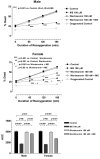Sex differences in the mechanism of Met5-enkephalin-induced cardioprotection: role of PI3K/Akt
- PMID: 17982014
- PMCID: PMC2596724
- DOI: 10.1152/ajpheart.00845.2007
Sex differences in the mechanism of Met5-enkephalin-induced cardioprotection: role of PI3K/Akt
Abstract
Met(5)-enkephalin (ME)-induced cardioprotection occurs via epidermal growth factor receptor (EGFR) transactivation with the subsequent activation of phosphatidylinositol 3-kinase (PI3K). In the present study, we investigated whether there is a sex difference in ME-elicited PI3K signaling. Neonatal murine cardiomyocytes were isolated by collagenase digestion and subjected to 90 min hypoxia and 180 min reoxygenation at 37 degrees C (n = 5 to 7 replicates). PI3K/Akt signaling was interrogated using pharmacological inhibitors and small interfering RNA (siRNA). Cell death was assessed by propidium iodide. More than 300 cells were examined for each treatment. The data are presented as means +/- SE. There was not a sex difference in the basal content of total Akt. ME (100 microM) elicited comparable protection in both sexes. Wortmannin and the nonselective Akt inhibitor IV completely abolished ME-induced protection in male cardiomyocytes but only attenuated protection in female cardiomyocytes. Isoform-selective knockdown of Akt in males with siRNAs against Akt1/2 completely abolished ME-induced cardioprotection, whereas the siRNAs against Akt3 only attenuated protection of approximately 40%. In contrast, in females the siRNAs against Akt1/2 attenuated and against Akt3 eliminated ME-induced cardioprotection. There is not a sex difference in the degree of ME-induced protection, and there is a sex difference in the cardioprotective signaling pathways after the administration of ME; ME-induced cardioprotection in males primarily utilizes a PI3K/Akt1/2 pathway and in females primarily utilizes a PI3K/Akt3 pathway. The incomplete loss of protection in females following the blockade of PI3K suggests that additional factors may facilitate the maintenance or function of activated Akt.
Figures







References
-
- Abramov D, Tamariz MG, Sever JY, Christakis GT, Bhatnagar G, Heenan AL, Goldman BS, Fremes SE. The influence of gender on the outcome of coronary artery bypass surgery. Ann Thorac Surg. 2000;70:800–805. - PubMed
-
- Arensburg J, Payne AH, Orly J. Expression of steroidogenic genes in maternal and extraembryonic cells during early pregnancy in mice. Endocrinology. 1999;140:5220–5232. - PubMed
-
- Bae S, Zhang L. Gender differences in cardioprotection against ischemia/reperfusion injury in adult rat hearts: focus on Akt and protein kinase C signaling. J Pharmacol Exp Ther. 2005;315:1125–1135. - PubMed
-
- Barrett-Conner E. Sex differences in coronary heart disease. Why are women so superior? The 1995 Ancel Keys lecture. Circulation. 1997;95:252–264. - PubMed
-
- Booth EA, Marchesi M, Kilbourne EJ, Lucchesi BR. 17beta-Estradiol as a receptor-mediated cardioprotective agent. J Pharmacol Exp Ther. 2003;307:395–401. - PubMed
Publication types
MeSH terms
Substances
Grants and funding
LinkOut - more resources
Full Text Sources
Research Materials
Miscellaneous

